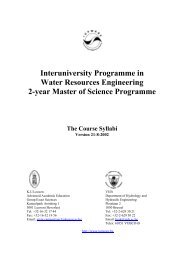CFHT operating manual - Homepage Usask
CFHT operating manual - Homepage Usask
CFHT operating manual - Homepage Usask
Create successful ePaper yourself
Turn your PDF publications into a flip-book with our unique Google optimized e-Paper software.
<strong>CFHT</strong> Observatory Manual - Site (Sec.2) http://www.cfht.hawaii.edu/Instruments/ObservatoryManual/CFH...<br />
Weather<br />
<strong>CFHT</strong> Observatory Manual<br />
Section 2 - SITE CHARACTERISTICS<br />
TABLE OF CONTENTS<br />
Mean minimum temperatures at the summit are around 0 C (summer) and -4 C (winter). Extreme<br />
temperatures hardly ever go lower than -10 C. Daytime temperatures are normally about 10 C in<br />
summer and 3 C in winter. Weather conditions in the Hawaiian Islands are determined largely by<br />
the strong persistent Northeast Pacific Ocean anticyclone, which usually gives rise to easterly<br />
(trade) winds in Hawaii, especially during the summer season. Trade winds give an inversion layer<br />
with an average height of 2000m; air above this inversion tends to be both dry and stable, hence<br />
giving the good astronomical quality usually experienced at the Observatory. At the mesoscale<br />
level, the summit of Mauna Kea is generally intercepting a free flow of air, thus preserving this good<br />
quality. However, high altitude cirrus can be a problem; in some years it has been present about<br />
30% of the time. The mean annual precipitation at the summit of Mauna Kea is ~15 cm, most of<br />
which falls as snow during the winter.<br />
Site Quality<br />
General characteristics include: 80% usable nights (55% photometric, 25% spectroscopic), median precipitable<br />
water<br />
vapor 0.9 mm.<br />
The median seeing (free atmosphere) is ~0.40 arc sec, with a likely systematic variation between winter (0.45)<br />
and<br />
summer (0.35). The 10 percentile is probably of the order of 0.25 arc sec. The summit of Mauna Kea appears to<br />
be in<br />
that respect, the best known site on earth. Observers must be cautioned, however, that seeing characteristics<br />
are often<br />
highly variable, even during the course of a single night.<br />
Image Quality<br />
A large sample of CCD images, either at prime or F/8 Cassegrain focus, have allowed good statistical<br />
study of the<br />
image quality with <strong>CFHT</strong>. Images are at the subarcsec level at least 75% of the time and long-exposure<br />
images with<br />
FWHM better than 0.4 arcsec have been obtained. The figure below shows the evolution of image quality<br />
as<br />
documented by science images taken since the beginning of <strong>CFHT</strong> operations. Note that the HRCam and<br />
SIS images<br />
have been taken with the instruments’ fast tip/tilt systems, and that the MOS images are badly<br />
under-sampled.<br />
1 of 8 08/07/04 11:20 PM

















